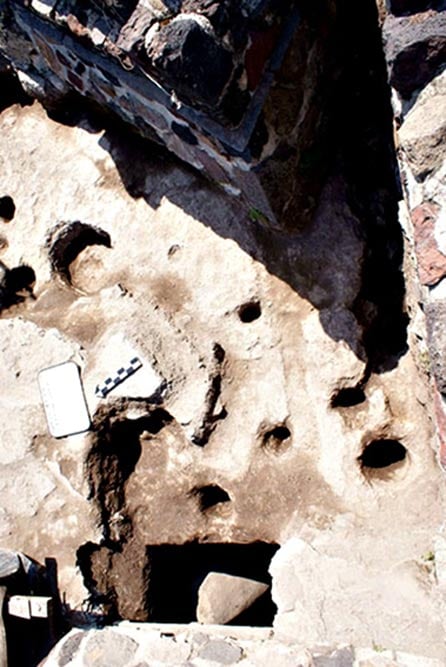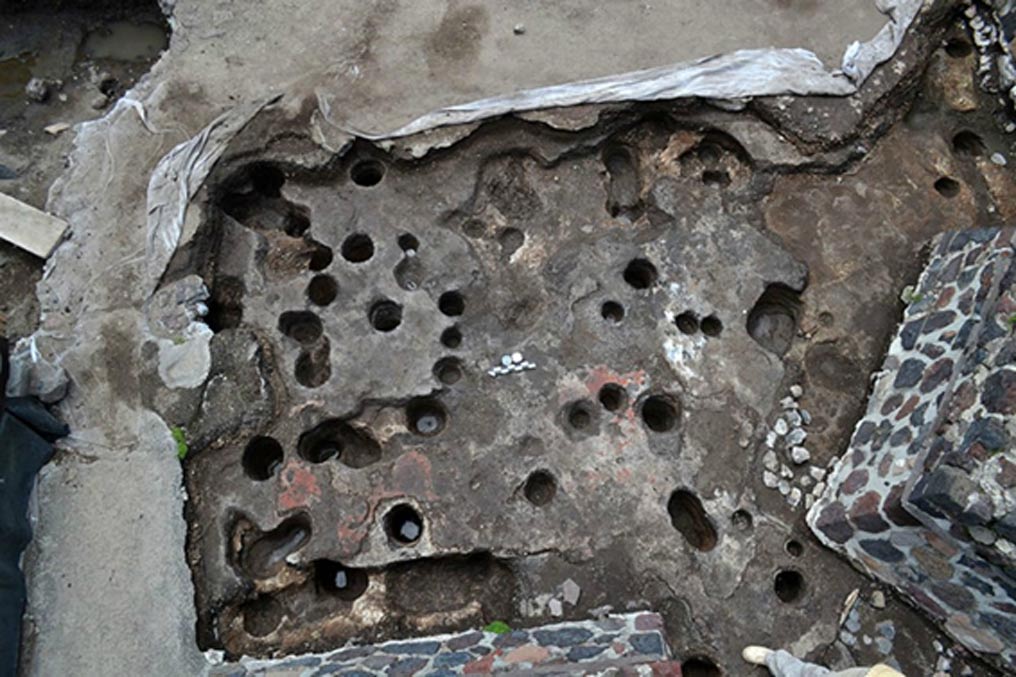Archaeologists Uncover a Symbolic Code Hidden in the Crater-Filled Plaza of the Moon in Teotihuacan
For weeks, archaeologists from the National Institute of Anthropology and History (INAH) of Mexico have been digging and exploring, for the first time, the bowels of the Plaza of the Moon at Teotihuacán. The team was surprised to find that when they saw the plaza facing the majestic Pyramid of the Moon from the air, it looked like a crater-packed moonscape.
They examined the series of holes and found that they had smooth green stone stelae inside them. The archaeologists also discovered passages that mark the center of this space with the directions of the universe (cardinal directions) and a series of holes containing river pebbles. All of these aspects make up a symbolic code that the ancient Teotihuacán people developed in the early stages of the city, almost 2,000 years ago.
"We are facing a new navel of the city, facing a new cosmic center. The Plaza of the Moon was not like we see it today. It was full of holes, canals, stelae, buildings were much more remote, and the Pyramid of the Moon was smaller. The limestone that forms the surface of the Plaza of the Moon was modified, we have identified more than 400 cavities that were used for over five centuries, small holes 20-25 centimeters [7.87-9.84 inches] in diameter and with depths of about 30 centimeters [11.81 inches] which cover the plaza, although the holes are more concentrated in certain areas. Many of them had river stones that were brought from elsewhere," reported Dr. Veronica Cabrera Ortega, director of the research project.

The excavations are being carried out under the surface of the Plaza of the Moon, in front of the Pyramid of the Moon. (Proyecto Estructura A, Plaza de la Luna, Teotihuacán, INAH)
The INAH says that the project is analyzing the heart of the Plaza of the Moon, a sector of great importance. The work, which began in 2015, resumed in early April and will be completed by the end of next July.
- Mesoamericans at Teotihuacan kept Ferocious Animals Captive and May Have Fed them with Humans
- Ancient tunnel under Teotihuacan may lead to Royal tombs
The excavations have focused on the area in front of the Pyramid of the Moon, known as Structure A: it is an enclosed patio that is 25 meters (82.02 feet) wide and it has 10 small altars in it. Through this work, they will try to find the origins of the ritual space of the Plaza of the Moon, and from boreholes created with the results of studies of the subsoil obtained through the use of ground penetrating radar, archaeologists have begun to recognize a series of alterations carried out by the Teotihuacán people. The modifications suggest an area that is very different from what is seen there today: that of a plaza bordered by 13 bases and the Pyramid of the Moon - which was built in the final stages of Teotihuacán (350-550 AD.)
So far, five full stelae have been found in the holes, with their heights ranging from 1.25 to 1.50 meters (4.10-4.92 ft.) and weights from 500 to 800 kgs. (1102.31-1763.70 lbs.) Pending the results of the various tests, it is possible that the green carved stones were from the region of Puebla, like another dozen stelae found earlier in Teotihuacán.

So far, five full stelae have been found in the holes. (Melitón Tapia INAH)
"Years ago the archaeologist Otto Schöndube said Structure A had a base that resembled a "quincunx" or "Teotihuacán cross," which is associated with a cosmological order, but there were no more elements to understand this. When we found these pits and the green stone stelae we started generating the idea that indeed this was a space with a symbolic linking of the underworld with the celestial plane," Verónica Ortega said in the INAH press release.
The stelae are located in spaces that measure 60 cm (23.62 inches) wide and between 3.5 and 4 meters (11.48-13.12 ft.) deep. The holes had to be dug in the early stages of the city (100 AD.) This was the same time as the Pyramid of the Sun was erected and when the first construction stage of the Pyramid of the Moon began. According to the expert of the INAH, this system of trenches was in use at least 500 years because there is evidence (ceramic material) that the pits were opened and sealed.
- Ancient People of Teotihuacan Drank Alcohol as Nutrient Booster
- Residents upset with greedy elites burned Teotihuacan
With respect to the stelae Ortega added:
"Eventually, the people of Teotihuacán decided to put them in a final place. The stelae were used to sanctify the space or legitimize the power assigned to the deities. Although we do not yet fully understand the context, this speaks to the importance of green stones and their link with water deities, here (the Plaza of the Moon) the greatest sculptures of the goddess of fertility, Chalchiuhtlicue, have been found, and it is likely that worship in this place was closely related to her. There are a lot of holes, it is likely that as part of a symbolic act, ceremony, or ritual, people come to this open space and deposited river pebbles within them, perhaps with an idea to promote fertility."

Some of the craters in the limestone and one of the holes with a green stela in the southern part of Structure A. (Proyecto Estructura A, Plaza de la Luna, Teotihuacán, INAH)
Another important finding was the discovery, just 10 cm (3.94 inches) below the surface, of two canals associated with the central altar of the Plaza of the Moon. It seems to have also had a symbolic function rather than acting as a drainage system. Both of them measure between 1.5 and 2 meters (4.92-6.56 ft.) wide and they start from the north and south of the altar steps towards these cardinal directions, reaching 25 meters (82.02 ft.) in length and up to 3 meters (9.84 ft.) deep.
"For the first time it is known that the open space is not necessarily void of archaeological evidence. In general, the public spaces of Teotihuacán, La Ciudadela and the plazas of the Sun and Moon pyramids had a symbolism beyond what we see as an architectural or urban project. Perhaps they made such changes to sanctify those spaces. Indeed, there is a whole underworld to know,” concluded the researcher in charge of this exciting project, which surely will bring more new and wonderful surprises.
A video showing the discoveries in Teotihuacán’s Plaza of the Moon. (In Spanish)
Featured Image: Holes located in the southeast corner of Structure A. (Proyecto Estructura A, Plaza de la Luna, Teotihuacán, INAH)
By Mariló T.A.
This article was first published in Spanish at http://www.ancient-origins.es and has been translated with permission.




















Comments
Are you talking about this article, or the site in general?
Either way, if you look at the history of scientific progress, you see that most facts (especially the really interesting ones) start out being “not believeable” to the vast majority of people, including scientists.
It seems to be a symptom of an affliction common to the human race: the delusion of omnipotence.
Some interesting articles, but one or two fantasy comments which do not really add to the believable facts which tend to spoil the integrity of the subject.